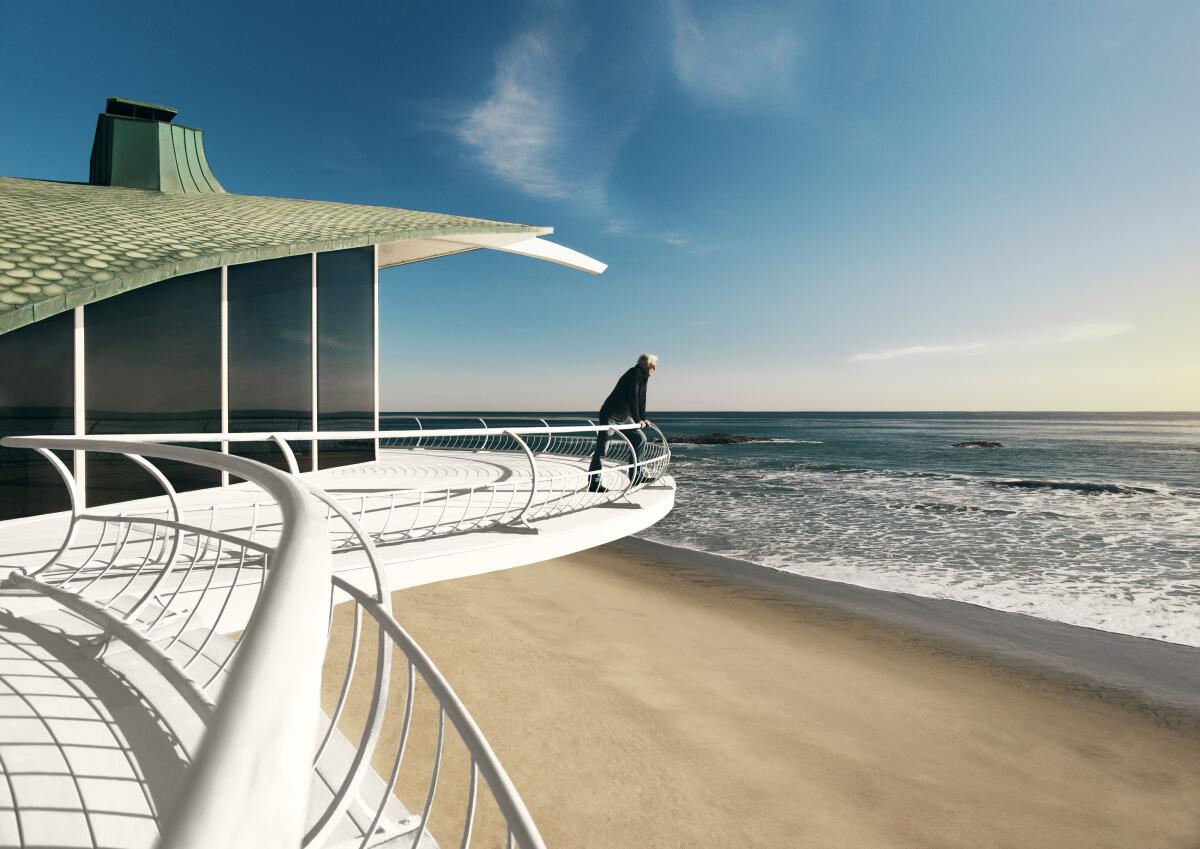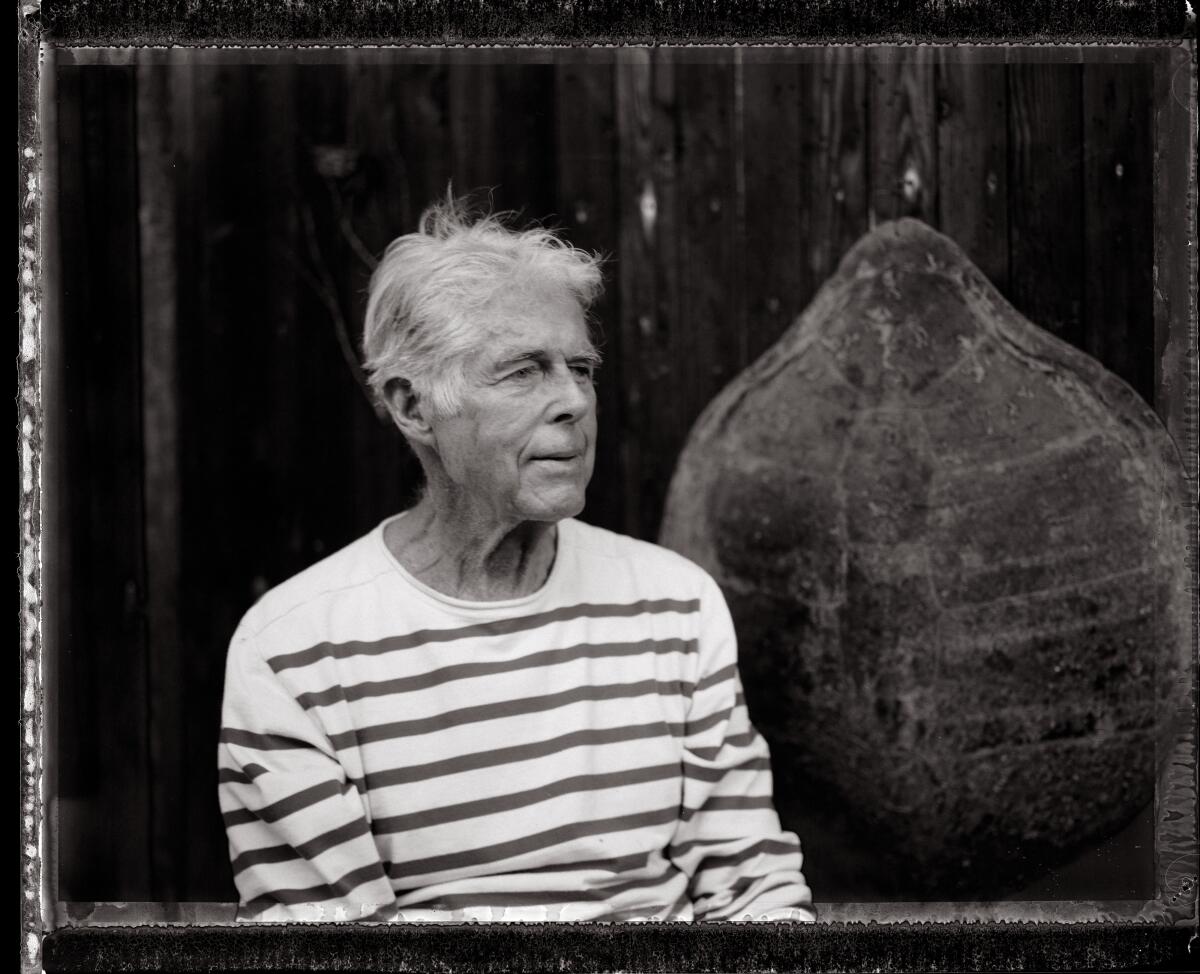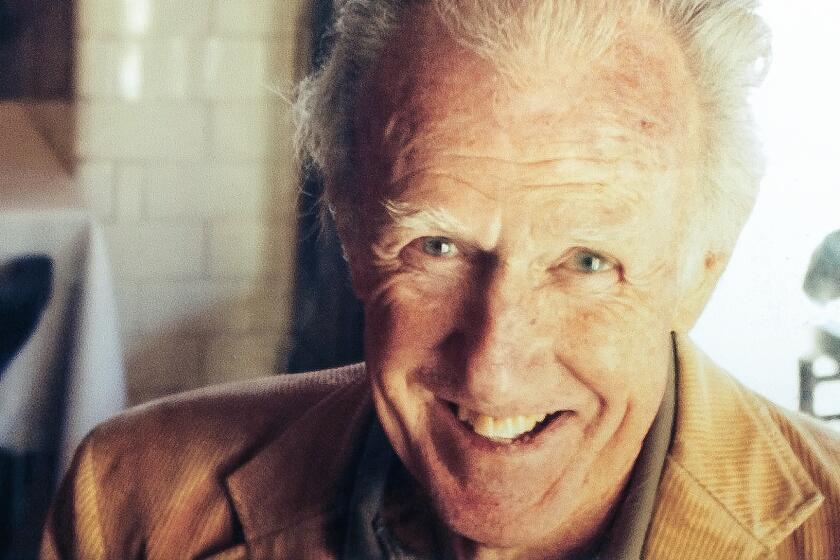Harry Gesner, designer who created Malibu’s crested ‘Wave House,’ dies at 97

- Share via
Harry Gesner was an architect who didn’t have a fancy degree — or, for many years, even an architectural license. In fact, the sum total of his training consisted of attending lectures by Frank Lloyd Wright, then working as a carpenter. The lack of credential was little deterrent to Gesner, who over the course of his life designed and crafted dozens of prized homes around Los Angeles.
These included the Cole House, built for swimwear magnate Fred Cole in 1954, a fantasy bachelor pad with a Polynesian air that became a darling of the era’s men’s magazines; as well as the Hollywood Boathouses, completed in 1959, a series of residences that cantilever over a steep hillside at the Cahuenga Pass, resembling space barges docked on the side of the mountain. (The site was so complicated to build on that Gesner got Norwegian shipbuilders to assist him with the task.)
He is perhaps best known, however, for the Wave House in Malibu, built in 1957, which juts out over the sand with a series of crested roofs that seem to evoke the forms of the waves that curl just below. In fact, Gesner later told Curbed that he designed the building “while sitting on a surfboard out by some rocks near the shore. I drew it on the board with a grease pencil.”
Gesner, who was known for designing some of L.A.’s most idiosyncratic residences, buildings that seem to draw their shape from the swells of the Pacific Ocean and the wooded peaks of the Santa Monica Mountains, died Friday in Malibu. He was 97 years old; the cause was complications related to cancer.
His death was confirmed by his stepson, Casey Dolan. In addition to Dolan, he is survived by daughter Tara Tanzer-Cartwright and sons Jason Gesner and Zen Gesner.

Gesner died in the seaside home he designed for himself and his family: an idiosyncratic structure known as the Sandcastle, which inhabited the same Malibu cove as the Wave House. Completed in 1970, the cylindrical home featured a storybook tower that had, at its heart, a brick fireplace and a window-lined common area fabricated from reclaimed wood.
The rounded design, he said, made efficient use of space and nodded to forms that exist in nature. “Go back through history,” he said. “Nests are round, everything is round, the Earth, planet solar systems, it’s all round. Why fight it?”
Zen Gesner said the house was “a dream” to grow up in. “It was the stuff of fairy-tale books. It was secret passageways and whimsical stained-glass windows that brought light into every room.”
In a city that gets conflated with fantasy, the late writer’s work gave permission to honor the details of everyday aesthetic experience.
Though a Modernist, Gesner was singular in his approach to his designs. In a 2012 monograph of his work, “Houses of the Sundown Sea: The Architectural Vision of Harry Gesner,” Lisa Germany notes that the architect resisted the “fine-boned” Modernism of Southern California midcentury, as embodied by the Case Study Houses, in favor of a more rugged look. Gesner, she wrote, embraced “the monumental details of the past — most notably castles and ships.”
His Eagle’s Watch House in Malibu, completed in 1957, takes the form of a triangle, with a roofline that extends over a hillside with a pointed beam — a form that resembles the prow of a ship.
“Everything was very natural. It was very organic,” says Lisa Stoddard, who for more than a decade served as the architect’s assistant and archivist. “It was very whimsical as well.”
Gesner designed dozens of homes around Southern California over the course of his career and continued to sketch out ideas until the end of his life — all from the tower in his home, where he would ascend daily to draw. Three or four years ago, when he became unable to make the climb, he’d draw at his desk or while lying in bed.
When asked by the New York Times in 2012 about which of his houses was his favorite, he replied, “It’s always the house I’m designing.”

If ever there were an architect with a Southern California pedigree, it was Gesner, a surfer with movie-star good looks and a taste for adventure.
Harry Harmer Gesner was born in Oxnard on April 25, 1925, the son of Harry Gesner, an inventor and engineer, and Ethel Harmer, an artist. On his mother’s side, his family stretches back to some of the earliest land-grant families in Santa Barbara, and his maternal grandfather, Alexander Harmer, was a well-known painter of Western scenes. Gesner also was related to John K. Northrop, inventor of the flying wing airplane and founder of the Northrop Corp.
When it came to design, the architect once told Vanity Fair, “The genes were all in line for me.”
When Gesner was a young boy, the family relocated to the Santa Monica area, where Gesner grew up, attending Santa Monica High School and learning to fly planes by the time he was a teenager. After graduation, he served in the military and was part of the the D-Day landing at Omaha Beach — an experience, he later wrote, in which he was “changed from a boy to a man after about a minute with the wounded, dying and about-to-be-dead.”
During the Battle of the Bulge, he was knocked unconscious by a piece of debris when a German tank blasted through the stone farmhouse he was hiding in. By the time he was taken to a hospital, he was near frozen and in danger of losing his legs. Dolan says his stepdad would often recall lying in his hospital bed, rubbing his legs to keep the blood circulating and thereby keep his limbs. Through sheer determination, he did.
For all of its devastations, the war helped feed his interest in architecture. Gesner often entertained himself in wartime Europe by sketching castles and even exploring them. “Castles are hands-on architecture,” he told the Getty Center blog in 2016. “The masons designed and built them, from the intricate knowledge they had in their heads. You don’t find plans for medieval castles.”
After he was discharged from the military, Gesner headed off to Ecuador to hunt for pre-Columbian artifacts. As he once told Architectural Digest, “I’m the original Indiana Jones.”
On his way back to Los Angeles, he stopped off in Mexico City, where he met actor Errol Flynn and ended up working as a deckhand on his yacht, the Sirocco.
Eclectic designer Bernard Judge, who helped preserve the historic Schindler House and built South Pacific lodging for Marlon Brando, dies at 90.
Gesner spent a brief stint in New York City on the GI Bill, taking the train up to New Haven, Conn., to attend lectures by Wright at Yale. But he declined to pursue formal studies in the field, returning instead to Los Angeles, where he worked in carpentry, masonry and whatever other building trades he could lay his hands on.
The first house he completed was for his parents; it was crafted out of adobe brick. He built other homes with adobe, but over time he became known for the ways he worked with wood — especially reclaimed wood, which he felt injected new life into a design.
Gesner also developed a reputation for his willingness to build on extremely difficult lots. Told a lot was unbuildable, he would pursue the project until he found a way to build it.
“He was indefatigable,” Dolan says. “He rarely rested. He always had projects in mind.”

In the Hollywood Hills, a scenic stunner known as the Flying Wing built by famed architect Harry Gesner just hit the market for $8 million.
Gesner also had a storied personal life — married four times over the course of more than six decades. This included a brief marriage to Audrey Hawthorne in the 1940s (Tanzer-Cartwright was born of that union), followed by a longer marriage to Patty Townsend in the 1950s, which didn’t bear any children. After his split from Townsend, he was wed to Patricia Alexander in the 1960s; they had a son, Jason. But soon they too divorced, and he ultimately married actress Nan Martin in 1969. They would remain married until her death in 2010. (Of Gesner’s ex-wives, only Alexander survives him.)
If his work was inspired by landscape, it also was inspired by his love affairs.
Gesner and Martin were classmates at Santa Monica High School but lost touch after Gesner was deployed to Europe. They reconnected at a high school event where Martin was being honored, and soon the two began a relationship. Stoddard recalls Gesner telling stories about taking Martin to the Malibu cove where he had bought a piece of land — a plot right next door to his Wave House.
“The story is that he built it for her,” says Stoddard. “He showed her the piece of land and said, ‘I’ll build you a sand castle on this piece of land if you’ll marry me.’”
She did. And it was the home where Gesner would draw his last breath.
More to Read
Start your day right
Sign up for Essential California for the L.A. Times biggest news, features and recommendations in your inbox six days a week.
You may occasionally receive promotional content from the Los Angeles Times.










